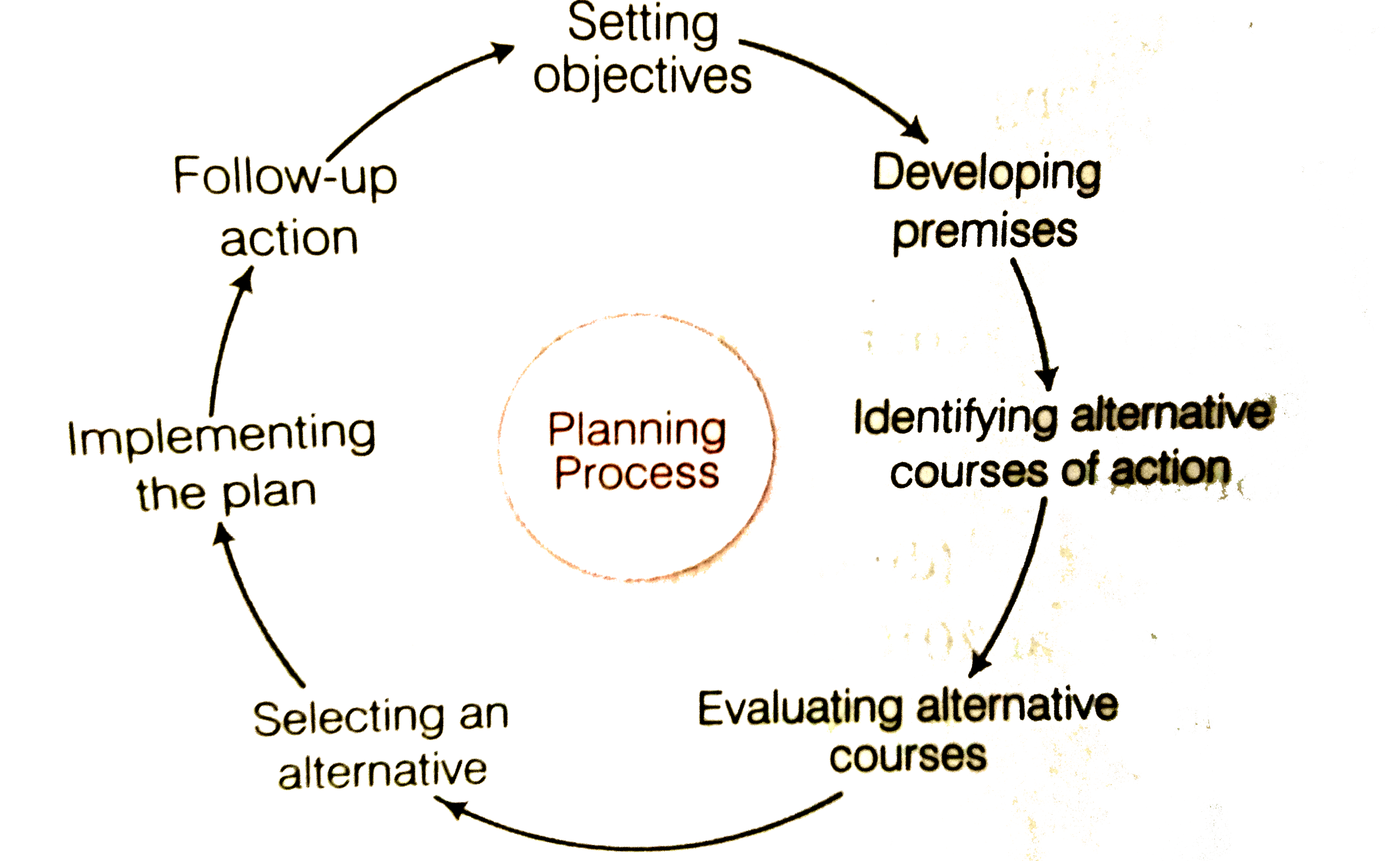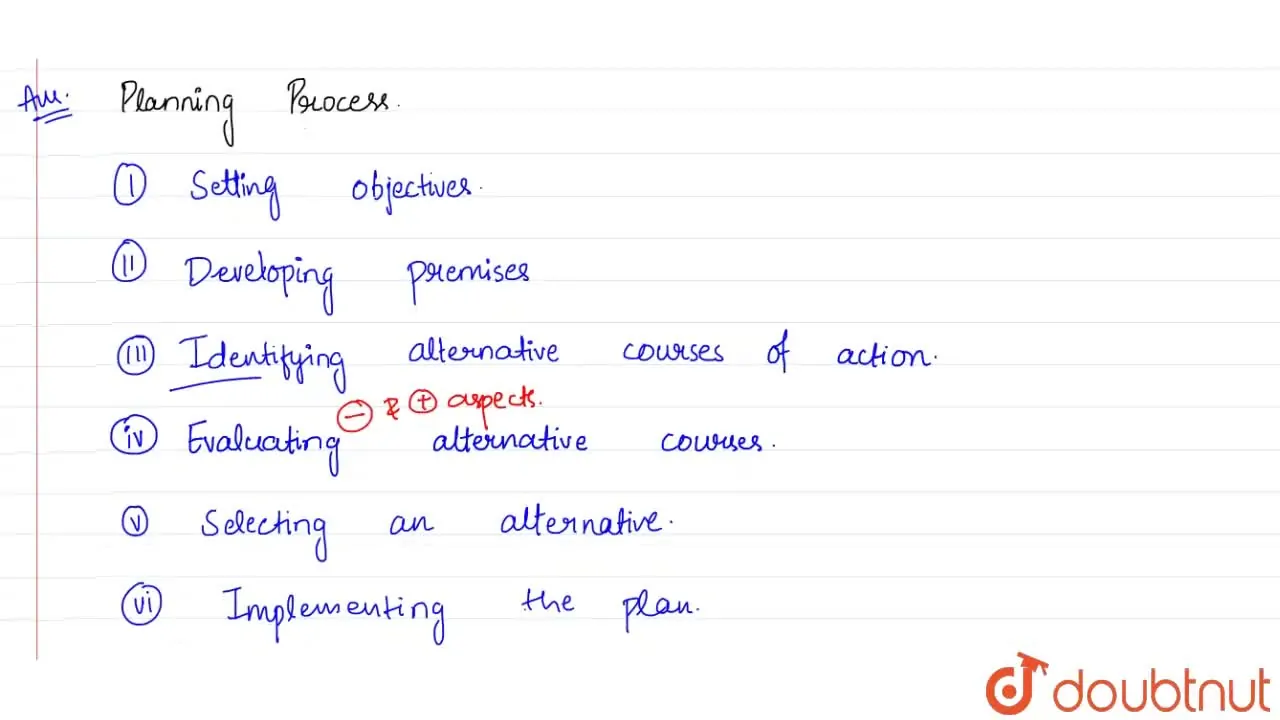Suryodaya Ltd appointed a team of five efficient managers to plan for its new project of building a residential colony For this, they are paid a huge amount of remuneration also
Explain the process that would be followed by the team
Planning is to decide in advance what to do and how to do It is an activity, which follows certain logical steps Setting objectives Every organisation operates to achieve certain objectives. Objectives specify what the organisation wants to achieve. Therefore, the first step in planning is to define and describe clearly the objectives of the organisation and each department or unit within the organisation. Once decided, these objectives should be communicated to all the units and employees.
(ii) Developing premises Planning is concerned with future, which is uncertain and every planner is using conjecture about what might happen in future.
Therefore, the manager is required to make certain assumptions about future. These assumptions are known as premises. Premises are the base, upon which plans are drawn. They may be forecasts, existing plans or past information.
(iii) Identifying alternative courses of action Once the objectives and planning premises are established, it becomes necessary to discover the various courses of action, which may be used to achieve the established objectives These alternatives may be routine or innovative. If the project is an important one, more alternatives should be identified
(iv) Evaluating alternative courses The next step is to weigh the pros and cons of each alternative. It is necessary to evaluate the positive and negative aspect of each alternative in the light of the objectives to be achieved. This might involve a number of calculations to measure the cost and benefits related to an alternative
(v) Selecting an alternative This is the real point of decision-making. The best plan has to be adopted and implemented. An ideal plan would be the one which is most profitable, most feasible and has the least negative consequences. Such judgement will depend upon the experience and intuition of the manager
(vi) Implementing the plan This step is concerned with putting the plan into action and doing what is required The managers start communicating the plans to employees and initiate them to carry out the activities according to the specifications of plans
(vii) Follow-up action Planning is a continuous process, so the managers keep on following up the plans to see that activities are performed as per the schedule or not. Monitoring the plans is important to ensure achievement of objectives

Related Playlists
- BOOK - ARIHANT PUBLICATIONCHAPTER - PLANNINGEXERCISE - SELF ASSESSMENT (MULTIPLE CHOICE )4videos
PLANNING
- BOOK - ARIHANT PUBLICATIONCHAPTER - PLANNINGEXERCISE - SELF ASSESSMENT (VERY SHORT ANSWER )4videos
PLANNING
- BOOK - ARIHANT PUBLICATIONCHAPTER - PLANNINGEXERCISE - CHAPTER PRACTICE (LONG ANSWER )9videos
PLANNING
- BOOK - ARIHANT PUBLICATIONCHAPTER - ORGANISINGEXERCISE - CBSE Examinations Archive (Long Anwer Type Questions)15videos
ORGANISING
- BOOK - ARIHANT PUBLICATIONCHAPTER - PRINCIPLES OF MANAGEMENTEXERCISE - CBSE EXAMINATIONS ARCHIVE ( LONG ANSWER)11videos
PRINCIPLES OF MANAGEMENT
Similar Questions
Managers at the operational or supervisory level make plans for
09:12View SolutionWhy is it said that organisations are not able to accomplish their goals without planning?
06:27View SolutionExplain Objective And 'strategy' as a type of plan.
04:06View SolutionExplain the concept of 'divisional structure'. Also, explain any four advantages of divisional structure.
01:49View SolutionKaran Nath took over D' north Motor Company from his ailing father three months ago. In the past, the company was not performing well Karan was determined to improve the company's performance He observed that the methods of production as well as selection of employees in the company were not scientific He believed that there was only one best method to maximise efficiency He also felt that once the method is developed, the workers of the company should be trained to learn that 'best method He asked the Production Manager to develop the best method and carry out the necessary training. The Production Manager developed this method using several parameters right from deciding the sequence of operations, place for men, machines and raw materials till the delivery of the product to the customers. This methods was implemented throughout the organisation. It helped in increasing the output, improving the quality and reducing the cost and wastage Identify and explain the principles and the technique of scientific management followed by the Production Manager in the above case
02:36View Solutionलेंथेनाइड आकुंचन या संकुंचन क्या है? इसका क्या कारण है? इसके प्रमुख प्रभाव की व्याख्या कीजिए ।
01:33View Solutionनिम्न का कारण स्पष्ट कीजिए - (क) जलोद्भिद में वायु अवकाश अत्यधिक विकसित होते है ,(ख) मध्योद्भिद पौधों को नमक के जल में रखने पर वे मर जाते है |
06:19View Solutionकपियो को मानव में बदलने के लिए कौन-से परिवर्तन करने की आवश्यकता होगी?
03:27View Solutionचित्रानुसार एक दण्ड चुम्बक मुक्त रूप से एक कुण्डली के बीच से होकर गिरता है। कारण सहित बताइए कि चुम्बक का त्वरण (a ) गुरुत्वीय त्वरण (g ) से कम अथवा समान अथवा अधिक होगा।
 03:01View Solution
03:01View Solutionपाच वर्ष पूर्व, A की आयु B से तीन गुनी थी तथा दस वर्ष बाद A की आयु B से दो गुनी होगो। A और B को बर्तमान आयु क्या हैँ?
05:21View Solutionएक छात्रावास के मासिक व्यय का एक भाग नियत है तथा शेष इस पर निर्भर करता है कि छात्र ने कितने दिन भोज- जब एक विद्यार्थी A को, जो 20 दिन भोजन करता है, ₹1000 छात्रावास के व्यय के लिए अंदा करने पड़ते हैं, विद्यार्थी B को, जो 26 दिन भोजन करता है छात्रावास के व्यय के लिए ₹1180 अदा करने पड़ते हैं। नियत व्यय के भोजन का मूल्य ज्ञात कीजिए।
01:59View Solutionसमस्याओ में रेखिक समीकरण युग्म बनाइए और उनके हल प्रतिस्थापन विधि द्वारा ज्ञात कीजिए :
एक क्रिकेट टीम के कोच ने 7 बल्ले तथा 6 गेंदे 3800 में खरीदी । बाद में उसने 3 बल्ले तथा 5 गेंदे 1750 में खरीदी ।बाद में , उसने 3 बल्ले तथा 5 गेद का मूल्य ज्ञात कीजिए ।02:17View Solutionसमस्याओ में रेखिक समीकरण युग्म बनाइए और उनके हल प्रतिस्थापन विधि द्वारा ज्ञात कीजिए :
एक नगर में टैक्सी के भाड़े में एक नियम भाड़े के अतिरिक्त चली गई दुरी पर भाड़ सम्मिलित किए जाता है। 10 किमी दुरी के लिए भाड़ा 105 है तथा 15 किमी के लिए भाड़ा क्या है ? एक व्यक्ति को 25 किमी यात्रा करने के लिए कितना भाड़ा देना होगा ?01:35View Solutionसमस्याओ में रेखिक समीकरणों के युग्म बनाइए और उनके हल (यदि उनका अस्तित्व हो ) विलोपन विधि से ज्ञात कीजिए :
किराए पर पुस्तके देने वाले किसी पुस्तकालय का प्रथम तीन दिनों का एक नियम किराया है तथा उसके बाद प्रत्येक अतिरिक्त दिन का अलग किराया है । सरिता ने सात दिनों तक एक पुस्तक रखने के लिए 27 अदा किए जबकि सुसी ने एक पुस्तक पाँच दिनों तक रखने के 21 ऐडा किए । नियत किराया तथा प्रत्येक अतिरिक्त दिन का किराया ज्ञात कीजिए ।01:15View Solutionसमस्याओ में रैखिक समीकरणो के युग्म बनाइए और अनके हल ( यदि उनका अस्तित्व हो ) किसी बीजगणितीय विधि से ज्ञात कीजिए :
एक छात्रावास के मासिक व्यय का एक भाग नियत है तथा शेष इस पर निर्भर करता है कि छात्र ने कितने दिन भोजन लिया है। जब एक विद्यार्थी A को, जो 20 दिन भोजन करता है, 1000 छात्रावास के व्यय के लिए अदा करने पड़ते हैं, जबकि एक विद्यार्थी बी को, जो 26 दिन भोजन करता है छात्रावास के व्यय के लिए 1180 अदा करने पड़ते हैं। नियत व्यय और प्रतिदिन के भोजन का मूल्य ज्ञात कीजिए।03:29View Solutionसिध्द कीजिए की c का एक ऐसा मान है जिसके लिए निकाय cx+3y=c−3 और 12x+cy=cके अपरिमित रूप से अनेक हल है इस मान ज्ञात कीजिए ।
04:21View Solution


